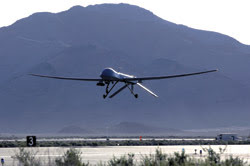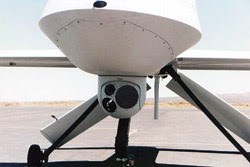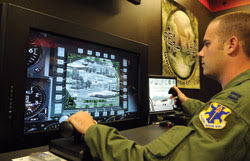Geoffrey MacGillivray, Pleora Technologies Inc.
For the military, knowing the location of your troops – and of the enemy – can be the difference between a successful operation and defeat. In modern warfare, that difference appears in the form of the Unmanned Aerial Vehicle (UAV), an all-seeing eye- in-the-sky platform that silently and out of view provides real-time video coverage of a battlefield. In fact, the UAV’s “raison d’être” lies in its advanced video capabilities.

Shown is an unmanned aerial vehicle used in modern warfare to provide real-time video coverage of battlefields.
UAVs are equipped with high-resolution multispectral imaging devices and are used for missions that are too tedious, dirty or dangerous for manned aircraft. They find use in a number of military roles, including reconnaissance (information gathering/surveillance), attack/offense, and search and rescue.
Typically, they have four to five high-speed cameras mounted around the aircraft, generating uncompressed video streams that later can be compressed. The military uses a variety of advanced radio and microwave technologies to send video to the command center, whereas video transmission from the cameras themselves within the aircraft is transmitted over Gigabit Ethernet (GigE) networks.

Pictured is the nose of an unmanned aerial vehicle equipped with a high-resolution multispectral imaging device.
This article takes a closer look at GigE Vision, an option for video transport used in UAVs that is becoming an increasingly common standard for military vehicles and aircraft.
GigE Vision, briefly
GigE Vision is an open framework for transferring imaging data and control signals between cameras and PCs over standard GigE networks. The control signals can adjust camera settings, pan-tilt-zoom equipment and more. Initially developed for and by the machine vision industry, it is now an open standard and not oriented to a single company’s technology. It aims to reduce the cost of systems and to make them easier to implement, use and maintain.
The military often is hesitant to use emerging video standards, but because this standard has matured and also is widely deployed in the scientific and medical industries, it is much more comfortable using it for its in-vehicle video transport.

An officer at Randolph Air Force Base operates the controls of a battlespace simulator in a training laboratory. Photos courtesy of the US Air Force.
The standard, which evolved from technology released by Pleora in 2002, has been incorporated in products from vendors worldwide as the video interface for mission-critical applications. The technology has gained widespread acceptance and is expected to enjoy steady growth in the future. In recent years, military systems integrators have deployed Pleora’s GigE-based technology in projects such as naval ships, Army personnel carriers and NASA space shuttles.
A host of benefits
Delivering video over Internet Protocol using the GigE Vision standard offers many benefits to the military industry, including networking flexibility, low latency, long cable distance, high bandwidth and support for compressed/uncompressed data.
Based on standard Gigabit Ethernet technology, it leverages the inherent power and flexibility associated with it, including reliability, full multicast support and scalability.
Multicast support enables users to send a single video source to a number of recipients simultaneously. This is crucial because video signals frequently are sent simultaneously to multiple groups inside UAVs – one stream to the onboard processor and one to the operator at the central command.
It also is easy to add sensors, displays and processing resources to GigE vision-based networks without changing the underlying protocol. The solution scales from simple point-to-point connections to more complex network topographies featuring multiple cameras and displays.
To make effective decisions in a military setting, live video must be received instantly. Latency for an application is defined as the time between the start of transmission of the image in the camera or video server to the time the image is fully received by the device and ready for display on a monitor. The calculation must include the time a packet is transported on the link as well as the store and forward times at each switch.
An advantage of using Gigabit Ethernet to transmit video images is its low latency. The pictures reaching the video monitor are virtually in sync with what is happening in real life and can be as low as 500 μs in a point-to-point configuration, depending on the image parameters. This is particularly important for UAV applications, where the operator maneuvers the aircraft by relying solely on the video information being supplied.
The standard supports cable lengths of up to 100 m in a point-to-point configuration – an advantage when it comes to mounting cameras in a large UAV. Alternative standards such as USB and IEEE 1394 are limited to cable lengths of 5 to 10 m. They offer insufficient flexibility, as cabling quickly gets used up when installing cameras inside an aircraft.
On the other hand, GigE Vision’s maximum flexibility with regard to camera placement makes it easy to achieve optimal visual coverage and allows deterministic, continuous data transfer at 1 Gb/s, enabling real-time, multimegapixel color imagery that outpaces USB and IEEE 1394. It also offers a natural upgrade path: The next generation, 10 GigE, offers transfer speeds of up to 10 Gb/s, and several companies already have begun introducing products based on it.
GigE Vision supports both compressed and uncompressed video, a key requirement for military applications in which images often are sent to multiple locations for different purposes and with different receiving capabilities and preferences.
Implementation
It is important to note that the standard not only does not define performance metrics, but it also does not specify targets. Although GigE Vision can transmit imaging data up to 1 Gb/s, a high-performance end-to-end solution that offers low latency and that does not need a large amount of CPU usage for simple image transfer requires high-quality hardware and software components throughout the signal chain, including the crucial device drivers. Each piece of the system affects the overall quality.
That is where implementation comes into play. Interested parties must look for an end-to-end solution that takes all of these considerations into account.
GigE Vision is a great fit for video transmission in military applications. It offers many features not supported by other video transport standards, such as networking flexibility, low latency, long cable distance, high bandwidth and support for compressed/uncompressed data.
Meet the author
Geoffrey MacGillivray is product manager at Pleora Technologies Inc. and manages the company’s iPORT and EtherCast product families; [email protected].